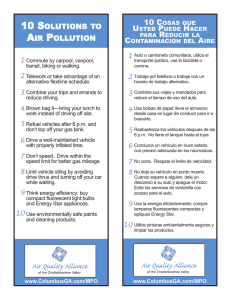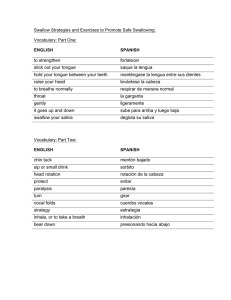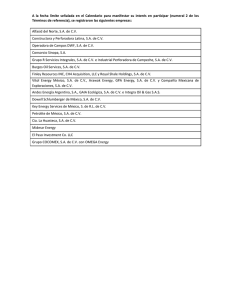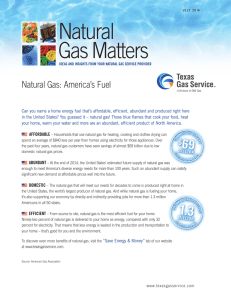home energy saving tips consejos para ahorrar
Anuncio
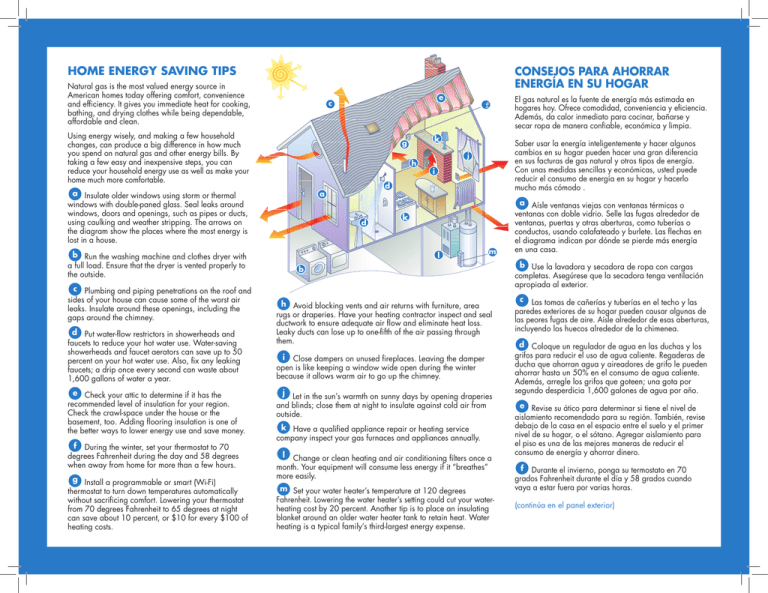
HOME ENERGY SAVING TIPS CONSEJOS PARA AHORRAR ENERGÍA EN SU HOGAR Natural gas is the most valued energy source in American homes today offering comfort, convenience and efficiency. It gives you immediate heat for cooking, bathing, and drying clothes while being dependable, affordable and clean. The most common places w here airmaking escapesainfew homes are: Using energy wisely, and household changes, can produce a big difference in how much you spend on naturalagasoors and bills. By , other a wlls , energy eilings c taking a few easy and inexpensive steps, you can ducts use as well as make your b energy reduce your household home much more comfortable. c replace a Insulate older windows using storm or thermal penetr ations d plumbing windows with double-paned glass. Seal leaks around windows, doors and openings, such as pipes or ducts, e doors using caulking and weather stripping. The arrows on the diagram show thef places where windo w s the most energy is lost in a house. g fans and entvs b Run the washing machine and clothes dryer with a full load. Ensure that dryer is vented elec tric out lets properly to h the the outside. c Plumbing and piping penetrations on the roof and sides of your house can cause some of the worst air leaks. Insulate around these openings, including the gaps around the chimney. d Put water-flow restrictors in showerheads and faucets to reduce your hot water use. Water-saving showerheads and faucet aerators can save up to 50 percent on your hot water use. Also, fix any leaking faucets; a drip once every second can waste about 1,600 gallons of water a year. e Check your attic to determine if it has the recommended level of insulation for your region. Check the crawl-space under the house or the basement, too. Adding flooring insulation is one of the better ways to lower energy use and save money. f During the winter, set your thermostat to 70 degrees Fahrenheit during the day and 58 degrees when away from home for more than a few hours. g Install a programmable or smart (Wi-Fi) thermostat to turn down temperatures automatically without sacrificing comfort. Lowering your thermostat from 70 degrees Fahrenheit to 65 degrees at night can save about 10 percent, or $10 for every $100 of heating costs. e c f k g h Saber usar la energía inteligentemente y hacer algunos cambios en su hogar pueden hacer una gran diferencia en sus facturas de gas natural y otros tipos de energía. Con unas medidas sencillas y económicas, usted puede reducir el consumo de energía en su hogar y hacerlo mucho más cómodo . i d a d k l El gas natural es la fuente de energía más estimada en hogares hoy. Ofrece comodidad, conveniencia y eficiencia. Además, da calor inmediato para cocinar, bañarse y secar ropa de manera confiable, económica y limpia. m b h Avoid blocking vents and air returns with furniture, area rugs or draperies. Have your heating contractor inspect and seal ductwork to ensure adequate air flow and eliminate heat loss. Leaky ducts can lose up to one-fifth of the air passing through them. i Close dampers on unused fireplaces. Leaving the damper open is like keeping a window wide open during the winter because it allows warm air to go up the chimney. Let in the sun’s warmth on sunny days by opening draperies and blinds; close them at night to insulate against cold air from outside. k Have a qualified appliance repair or heating service company inspect your gas furnaces and appliances annually. l Change or clean heating and air conditioning filters once a month. Your equipment will consume less energy if it “breathes” more easily. m Set your water heater’s temperature at 120 degrees Fahrenheit. Lowering the water heater’s setting could cut your waterheating cost by 20 percent. Another tip is to place an insulating blanket around an older water heater tank to retain heat. Water heating is a typical family’s third-largest energy expense. a Aísle ventanas viejas con ventanas térmicas o ventanas con doble vidrio. Selle las fugas alrededor de ventanas, puertas y otras aberturas, como tuberías o conductos, usando calafateado y burlete. Las flechas en el diagrama indican por dónde se pierde más energía en una casa. b Use la lavadora y secadora de ropa con cargas completas. Asegúrese que la secadora tenga ventilación apropiada al exterior. c Las tomas de cañerías y tuberías en el techo y las paredes exteriores de su hogar pueden causar algunas de las peores fugas de aire. Aísle alrededor de esas aberturas, incluyendo los huecos alrededor de la chimenea. d Coloque un regulador de agua en las duchas y los grifos para reducir el uso de agua caliente. Regaderas de ducha que ahorran agua y aireadores de grifo le pueden ahorrar hasta un 50% en el consumo de agua caliente. Además, arregle los grifos que goteen; una gota por segundo desperdicia 1,600 galones de agua por año. e Revise su ático para determinar si tiene el nivel de aislamiento recomendado para su región. También, revise debajo de la casa en el espacio entre el suelo y el primer nivel de su hogar, o el sótano. Agregar aislamiento para el piso es una de las mejores maneras de reducir el consumo de energía y ahorrar dinero. f Durante el invierno, ponga su termostato en 70 grados Fahrenheit durante el día y 58 grados cuando vaya a estar fuera por varias horas. (continúa en el panel exterior) g Instale un termostato programable o inteligente (Wi-Fi) para bajar la temperatura automáticamente sin sacrificar comodidad. Por ejemplo, bajar su termostato de 70 grados Fahrenheit a 65 grados por la noche, podría ahorrarle aproximadamente un 10% o $10 por cada $100 de costos de calefacción. h Evite bloquear las rejillas de ventilación y retornos de aire con muebles, tapetes o cortinas. Pida a su contratista de calefacción que inspeccione y selle el sistema de conductos para asegurar que haya un flujo de aire suficiente y eliminar la pérdida de aire caliente. Los conductos pueden perder hasta un quinto del aire que pasa por ellos. Ways to Save Energy and Money Maneras de ahorrar energía y dinero TOOLS TO MANAGE YOUR ENERGY USE Atmos Energy has free tools and information to help you manage your energy use. Learn more by going to www.atmosenergy.com/energytips. Create a personalized ENERGY SNAPSHOT for your home. Input your energy use and take an online survey about your house and lifestyle to receive free energy-saving advice. The ENERGY CALCULATOR shows how much it costs to operate a wide variety of appliances, both natural gas and electric. i Cierre los reguladores de tiro de las chimeneas cuando no están en uso. Dejarlos abiertos es como mantener una ventana abierta durante el invierno, ya que el aire caliente sube por la chimenea. Use the COMPARISON TOOL to quickly compare the estimated annual energy use and operating costs for new or existing heating and cooling equipment, water heaters, or lighting in your home. Para dejar entrar el calor del sol los días soleados, abra las cortinas y persianas; luego, ciérrelas de noche para aislarse del aire frío de afuera. CÓMO MANEJAR SU CONSUMO DE ENERGÍA k Haga inspeccionar su calentador y otros equipos de gas natural anualmente por una compañía calificada de reparación de equipos o de calefacción. Atmos Energy tiene herramientas e información gratuitas para ayudarle a manejar su consumo de energía. Para aprender más, visite www.atmosenergy.com/energytips. l Cambie o limpie los filtros de la calefacción central una vez por mes. Estas unidades consumen menos energía si “respiren” más fácilmente. Cree un PERFIL DE CONSUMO DE ENERGÍA personalizado para su hogar. El perfil usa sus respuestas a una encuesta electrónica sobre su casa y su estilo de vida para ofrecerle consejos gratuitos sobre maneras de ahorrar energía. m Ponga la temperatura de su calentador de agua en 120 grados Fahrenheit. Bajar la temperatura de su calentador de agua podría reducir el costo de calentar el agua en un 20%. Otro consejo es colocar una manta aislante sobre el tanque de un calentador de agua viejo para conservar el calor. El calentamiento de agua típicamente es el tercer gasto más grande de energía de una familia. LA CALCULADORA DE ENERGÍA muestra cuánto cuesta operar una gran variedad de aparatos eléctricos y de gas natural. Use la HERRAMIENTA DE COMPARACIÓN para comparar fácilmente el consumo de energía anual estimado y los costos de operar aparatos nuevos o existentes de calefacción, aire acondicionado, calentadores de agua y luz en su hogar. atmosenergy.com © 2016 Atmos Energy Corporation. All rights reserved. Todos los derechos reservados. Your natural gas company
